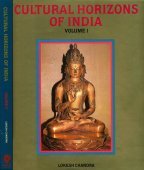Transmission: 1 definition
Introduction:
Transmission means something in the history of ancient India. If you want to know the exact meaning, history, etymology or English translation of this term then check out the descriptions on this page. Add your comment or reference to a book if you want to contribute to this summary article.
India history and geography
Source: Singhi Jain Series: Ratnaprabha-suri’s Kuvalayamala-katha (history)Transmission (of occult religion) was done through mediums known as Vidyādhara godlings, according to the Jain occult religion and Śabaravidyā cult practices and beliefs of ancient India, as depicted in the Kathās (narrative poems) such as Uddyotanasūri in his 8th-century Kuvalayamālā (a Prakrit Campū, similar to Kāvya poetry).—It appears that during the 8th century, in the time of Uddyotanasūri, Jaina occult religion and mysticism brought into close touch such practices as Śabaravidyā of which Vidyādhara godlings were considered medium of transmission (133.9-10). The shrine of Ṛṣabhanātha became a centre for performance of sādhanā and for the perfection of Vidyās.

The history of India traces the identification of countries, villages, towns and other regions of India, as well as mythology, zoology, royal dynasties, rulers, tribes, local festivities and traditions and regional languages. Ancient India enjoyed religious freedom and encourages the path of Dharma, a concept common to Buddhism, Hinduism, and Jainism.
See also (Relevant definitions)
Ends with: Genetic transmission.
Full-text (+716): Abhivahya, Ashtavimshati, Ajnananda, Kramadiksha, Lekhanapaddhati, Caturvaktra, Niriha, Transamisana, Preshitra, Samcara, Transmisan, Preshana, Madhyakrama, Samcarana, Nanamnaya, Jyeshthakrama, Nyasa, Tarangasanchaaran, Anuvamshiyate, Mahakrama.
Relevant text
Search found 96 books and stories containing Transmission; (plurals include: Transmissions). You can also click to the full overview containing English textual excerpts. Below are direct links for the most relevant articles:
Maha Prajnaparamita Sastra (by Gelongma Karma Migme Chödrön)
IV. How to prevent the interruption of the Buddha fields < [Part 4 - Assuring the continuity of the Buddha universes]
II. Being the assistant of the Buddha < [Part 3 - Acquiring precedence, etc.]
Visuddhimagga (the pah of purification) (by Ñāṇamoli Bhikkhu)
Guhyagarbha Tantra (with Commentary) (by Gyurme Dorje)
2. Compilation of the Kangyur and Nyingma Tantras < [Introduction]
Text 15.3 (Commentary) < [Chapter 15 (Text and Commentary)]
Blue Annals (deb-ther sngon-po) (by George N. Roerich)
Chapter 3 - Tranmission in Tibet < [Book 10 - The Kālacakra]
Chapter 1 - Principally on the Magical Illusion (māyajāla) < [Book 3 - Early translations of Secret Mantra]
Chapter 1b - Detailed transmission history from dynastic period < [Book 3 - Early translations of Secret Mantra]
Bhesajjakkhandhaka (Chapter on Medicine) (by Hin-tak Sik)
Chapter Summary < [Chapter 4 - Medicinal Substances in the Chapter on Medicine]
Contributions of this Study < [Chapter 6 - Conclusion]
Limitations of this thesis and future research directions < [Chapter 6 - Conclusion]
Dhyana in the Buddhist Literature (by Truong Thi Thuy La)
3.3 (a): The Origin of the Transmission (of Enlightenment in India) < [Chapter 3 - The Dhyāna in Mahāyāna Literature]
1.1: Introducing the Problem < [Chapter 1 - Introduction]
3.4 (a): Bodhidharma and Hui K’o (3rd–4th century CE) < [Chapter 3 - The Dhyāna in Mahāyāna Literature]
Related products


